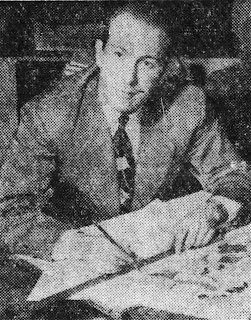Saturday, January 15, 2022
Herriman Saturday: March 11 1910
March 11 1910 -- A very strange cartoon by Herriman, odd enough that one wonders if Garge might have had a little TOO much fun at the ballpark before dipping his pen. Or, maybe if we knew the details of that game everything would be perfectly reasonable. I dunno.
The strip is made only more impenetrable by the condition of the paper. Beyond the typical woes of dealing with microfilm, this paper was torn, missing the upper left side, and looked like it had gotten wet, making the ink blot and bleed. Thankfully most of the Examiner material is in better condition than this.
Labels: Herriman's LA Examiner Cartoons
Friday, January 14, 2022
Ink-Slinger Profiles by Alex Jay: Ray Hudson
Miss Barbara Anderson, daughter of Mr. and Mrs. Walter Anderson of Chicago, became the bride of G. Raymond Hudson, son of Mr. and Mrs. George Hudson of Coolidge Road, July 9 in the Bryn Mawr Community Church in Chicago. A reception was held in the home of the bride’s parents following the ceremony. Mr. and Mrs. Hudson left immediately afterwards for San Antonio, Tex., where Mr. Hudson is affiliated with the Army Air Forces at Kelly Field. Both he and Mrs. Hudson are graduates of Denison University.
Labels: Ink-Slinger Profiles
Wednesday, January 12, 2022
Obscurity of the Day: Travelin' Ted
Travelin' Ted was a weekly panel cartoon that ran in the Chicago Sunday Tribune's travel section each week from September 17 1950 to March 2 1952. Each episode would offer information about a particular vacation destination, including a special tip from the panel's mascot, Travelin' Ted himself.
The creator, Ray Hudson, was employed by the Tribune as a designer, and apparently he was responsible for the much of the very attractive graphic content of their Sunday travel sections, supplying art for advertisers who contracted with the paper for ad design services.
As far as is known, this was Hudson's only foray into newspaper cartooning.
Labels: Obscurities
Despite Hudson's connexion to the ChiTrib, one sample shows it's copyrighted in his own name. Would this be syndicated, perhaps for small town weeklies?
--Allan
Monday, January 10, 2022
Obscurity of the Day: Sambo Remo Rastus Brown is Now a Policeman
Today Clare Briggs is mostly remembered, by those who remember him at all, for his daily series with running titles like When a Feller Needs a Friend, The Days of Real Sport, and Somebody's Always Taking the Joys Out of Life. What is seldom recalled is that in his days at the Chicago Tribune he created a long-running and popular Sunday series titled Danny Dreamer. That was a strip about a kid who's imagination was compared in each episode with considerably different reality.
After about four years milking that plot, Briggs tired of it and shifted the focus to Danny's father, who luckily enough also turned out to have a vivid imagination. Shortly after making that switch, though, Briggs seems to have realized that Senior was too generic of a character for the comics section, so he gave him a wacky black sidekick to liven things up, and dropped the reality vs. imagination schtick in favour of physical comedy with the inevitable racial overtones.
That sidekick was Sambo Remo Rastus Brown, and he came completely equipped with all the hoary black stereotypes typical of the era. Brown's role in Danny Sr.'s life is never fleshed out, but he seems to live with the Dreamer family, so perhaps he was what was then called a "hired man", sort of the male version of a maid, tasked with all manner of male-oriented work around the house.
After almost a year of Dreamer Sr. and Brown sharing the spotlight, Briggs decided that Sambo Remo was the only real draw and so he put the whole Dreamer family out to pasture. Since the new star needed to go out on his own, Briggs decided it would be hilarious to have a black man as a policeman. Not that black policemen were totally unknown in this era, but it can be safely assumed that their patrols were generally limited only to black neighborhoods.
In the new series, with the unwieldy title of Sambo Remo Rastus Brown is Now a Policeman, much of the comedy would come from Sambo Remo interacting with white folk who don't take well to him being a figure of authority. Since you can easily imagine how those gags went, I've decided to instead include the above superb fourth-wall breaking strip that is not at all typical fare for the series.
Sambo Remo Rastus Brown is Now a Policeman, which I count as a separate series though it has family ties to Danny Dreamer, ran from October 13 1912 to February 23 1913.
A minor mystery about this series: for some reason Briggs never signed the strip once it gained this new title. It certainly appears to be his work, so I don't know why there would have been such an abrupt change.
Labels: Obscurities
Sunday, January 09, 2022
Wish You Were Here, from Albert Carmichael
Here's a card from Carmichael's "If" series, published by Samson Bros. as Series 262 in 1910. I think this series represents some of Carmichael's best work; he's really getting the hang of things, and maybe Samson paid well enough that he could afford to spend a little extra time refining his drawings on these cards.
Labels: Wish You Were Here







